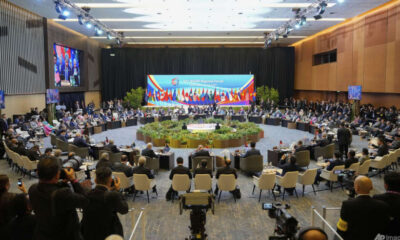Politics
US’s Failed ‘Pivot to Asia’: A Decade of Missed Opportunities

More than a decade after President Barack Obama introduced the concept of America’s “pivot to Asia” in 2011, a thorough evaluation reveals a stark reality. The expected strategic shift has not materialized, instead highlighting a pattern of overreach against the backdrop of geopolitical complexities. Initially branded as a “rebalance,” the strategy aimed to realign U.S. foreign policy towards Asia, acknowledging the region’s growing significance.
The pivot outlined key priorities: strengthening bilateral security alliances, enhancing relationships with emerging powers, engaging regional institutions, and promoting trade and investment. While the vision appeared comprehensive and forward-thinking, actual implementation has been fraught with challenges. Instead of executing a seamless transition away from Middle Eastern conflicts, the U.S. has remained entrenched in various crises—from Afghanistan to Syria, and more recently, Ukraine and Iran.
### Overlooked Realities of Global Crises
The fundamental flaw in the pivot was the assumption that the U.S. could dictate its strategic priorities without acknowledging the reality of global crises. Despite Washington’s intent to focus on Asia, events in the Middle East demanded urgent attention and resources. The Arab Spring, the rise of ISIS, Iran’s nuclear ambitions, and the enduring Israeli-Palestinian conflict diverted American focus, illustrating a significant miscalculation regarding the limits of American influence.
U.S. policymakers have often operated under outdated beliefs about their global reach, mistakenly compartmentalizing regions and threats. While American strategists were penning white papers on the importance of Asia, China was actively reshaping the region. Through initiatives like the Belt and Road Initiative, military modernisation, and economic influence, China has effectively altered the balance of power in Asia, all while the U.S. struggled to shift its focus.
### Mixed Outcomes for Alliances and Trade
The pivot’s focus on strengthening alliances yielded mixed results. Collaborations with nations such as Japan, Australia, and India have developed, notably through the Quadrilateral Security Dialogue (Quad). Yet, these partnerships have faced complications. As U.S. leverage wanes, India has begun to pursue a more independent foreign policy, exemplified by Prime Minister Narendra Modi‘s recent visit to China, his first in over seven years.
Economic strategies linked to the pivot have faltered significantly. The Trans-Pacific Partnership, once seen as the cornerstone of U.S. economic strategy in Asia, was abandoned by the first administration of Donald Trump. Meanwhile, China has advanced its own economic initiatives, such as the Regional Comprehensive Economic Partnership, which notably excludes the U.S. Trump’s tariff regime, described as “Liberation Day,” has imposed sweeping tariffs on all member states of the ASEAN, creating economic turmoil in a region heavily reliant on U.S. trade.
### Strategic Missteps and Future Directions
The challenges facing the pivot stem from several strategic errors. Initially, it assumed America could redefine global priorities unilaterally without considering the reactions of other powers, particularly China. Additionally, it overlooked the interconnectedness of global issues and failed to integrate its pivot with existing commitments. Furthermore, domestic political dynamics, particularly skepticism regarding foreign engagements, were inadequately addressed.
Looking ahead, U.S. policymakers must adopt a more realistic view of Asia. The region is unlikely to be dominated by any single nation, including the U.S. Instead, the future will likely be characterized by managed competition and selective cooperation among various powers. Prioritizing economic engagement rather than military dominance will be essential for enhancing influence.
The U.S. and Japan’s recent revival of outdated geopolitical frameworks suggests a failure to grasp the evolving landscape of Asian geopolitics. While the pivot to Asia was not misguided—Asia remains central to global affairs—it was built on an exaggerated sense of American agency and a misunderstanding of how power dynamics function today.
The critical question now is not what happened to the pivot but whether U.S. foreign policy can adapt to recognize the need for shared leadership in a region where it will continue to play an important role but no longer as the singular dominant force. Until such an evolution occurs, American strategy in Asia will likely remain reactive, lacking the coherence necessary for addressing the complexities of a rapidly changing global order where China rises and U.S. influence wanes.
Leon Hadar, an author of “Sandstorm: Policy Failure in the Middle East,” provides a compelling perspective on these issues, reflecting on the intricate relationship between U.S. foreign policy and the dynamic realities of international relations.
-

 Lifestyle3 months ago
Lifestyle3 months agoHumanism Camp Engages 250 Youths in Summer Fest 2025
-

 Sports3 months ago
Sports3 months agoDe Minaur Triumphs at Washington Open After Thrilling Comeback
-

 Business4 months ago
Business4 months agoKenvue Dismisses CEO Thibaut Mongon as Strategic Review Advances
-

 Sports4 months ago
Sports4 months agoTupou and Daugunu Join First Nations Squad for Lions Clash
-

 Top Stories4 months ago
Top Stories4 months agoColombian Senator Miguel Uribe Shows Signs of Recovery After Attack
-

 World4 months ago
World4 months agoASEAN Gears Up for Historic Joint Meeting of Foreign and Economic Ministers
-

 Business4 months ago
Business4 months agoOil Prices Surge Following New EU Sanctions on Russia
-

 Health3 months ago
Health3 months agoNew Study Challenges Assumptions About Aging and Inflammation
-

 Entertainment3 months ago
Entertainment3 months agoDetaşe-Sabah Violin Ensemble Captivates at Gabala Music Festival
-

 Entertainment3 months ago
Entertainment3 months agoBaku Metro Extends Hours for Justin Timberlake Concert
-

 Business4 months ago
Business4 months agoU.S. House Approves Stablecoin Bill, Sends to Trump for Signature
-

 Top Stories4 months ago
Top Stories4 months agoRethinking Singapore’s F&B Regulations Amid Business Closures









